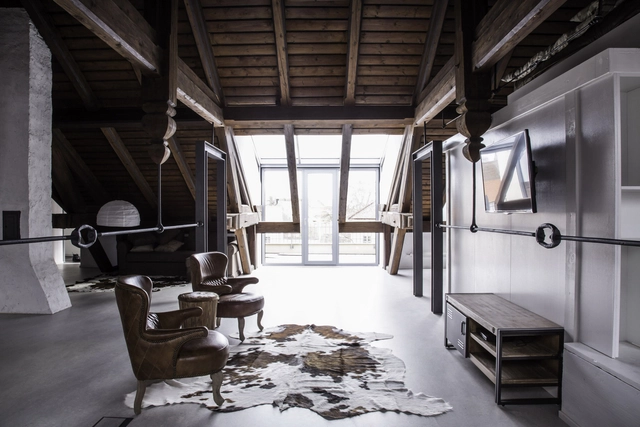
Refurbishment: The Latest Architecture and News
Spring, Summer, Fall, Winter... and Spring / ORA
https://www.archdaily.com/597478/spring-summer-fall-winter-and-spring-oraKaren Valenzuela
Octapharma Brewery / Joliark
https://www.archdaily.com/598517/octapharma-brewery-joliarkKaren Valenzuela
Elwood House / Preston Lane

-
Architects: Preston Lane
- Area: 372 m²
- Year: 2014
-
Manufacturers: PFLEIDERER, Sculptform, About Space, Cement Australia, Cheminees Philippe, +15
https://www.archdaily.com/598585/elwood-house-preston-laneKaren Valenzuela
Pace Gallery / HS2 Architecture

-
Architects: HS2 Architecture
- Area: 10000 ft²
- Year: 2012
-
Manufacturers: Lynbrook Glass
-
Professionals: CODE LLC, Philip Monat Lighting Design, Robert Silman Associates, Tenen, Irwin Associates
https://www.archdaily.com/599517/pace-gallery-hs2-architectureCristian Aguilar
Silesian Museum Katowice / Riegler Riewe Architekten

-
Architects: Riegler Riewe Architekten
- Area: 25067 m²
- Year: 2013
-
Professionals: Budimex, Firma Inżynierska Statyk, Katowice, Riegler Riewe Architekten ZT-Ges.m.b.H.
https://www.archdaily.com/598987/silesian-museum-katowice-riegler-riewe-architektenCristian Aguilar
Vilnius SPA - Anykščiai / SP Architektu Grupe

-
Architects: SP Architektu Grupe
- Year: 2014
https://www.archdaily.com/589699/vilnius-spa-anyksciai-sp-architektu-grupeCristian Aguilar
Kilic Ali Pasa Hamam / Cafer Bozkurt Architecture

-
Architects: Cafer Bozkurt Architecture
- Area: 935 m²
- Year: 2011
-
Professionals: 3A Engineering, Coskun Ozbas Engineering
https://www.archdaily.com/589511/kilic-ali-pasa-hamam-cafer-bozkurt-architectureCristian Aguilar
H71a / Studio Granda

-
Architects: Studio Granda
- Area: 231 m²
-
Professionals: Efla, VJÍ, ÞB verktakar
https://www.archdaily.com/587110/h71a-studio-grandaDaniel Sánchez
House of Vans London / Tim Greatrex
.jpg?1420846842&format=webp&width=640&height=580)
-
Architects: Tim Greatrex
- Area: 2500 m²
- Year: 2014
-
Manufacturers: Dalhaus
-
Professionals: Building Construction Solutions (BCS), Chapman Ventilation, Line skateparks, Mecserve
https://www.archdaily.com/585818/house-of-vans-london-tim-greatrexCristian Aguilar
Vorarlberg Museum / Cukrowicz Nachbaur Architekten

-
Architects: Cukrowicz Nachbaur Architekten
- Area: 6100 m²
- Year: 2012
-
Manufacturers: CYMISA, din Sicherheitstechnik
https://www.archdaily.com/585185/vorarlberg-museum-bregenz-austria-cukrowicz-nachbaur-architekteKaren Valenzuela
Red Dot Hotel / Steven Wu+Wang Pe-Jen

-
Architects: Steven Wu+Wang Pe-Jen
- Area: 360 m²
- Year: 2014
https://www.archdaily.com/585275/red-dot-hotel-steven-wu-wang-pe-jenCristian Aguilar
Camperdown Childcare / CO-AP
https://www.archdaily.com/584781/camperdown-childcare-co-apKaren Valenzuela
Siu Siu – Lab of Primitive Senses / DIVOOE ZEIN Architects

-
Architects: DIVOOE ZEIN Architects
- Area: 270 m²
- Year: 2014
-
Professionals: Divooe Zein Interior Design Group
https://www.archdaily.com/579478/siu-siu-nil-lab-of-primitive-senses-divooe-zein-architectsKaren Valenzuela
Extension of a House in Bořislav / 3+1 architekti
https://www.archdaily.com/572654/extension-of-a-house-in-borislav-3-1-architektiCristian Aguilar
Expansion of the American School of the Hague / Kraaijvanger

-
Architects: Kraaijvanger
- Area: 3900 m²
- Year: 2013
-
Manufacturers: INNTEC, UCS Forest Group
-
Professionals: ABT, Velp, Blanksmagroep, Deerns, designstudio van ginneken
https://www.archdaily.com/577123/expansion-of-the-american-school-of-the-hague-kraaijvangerDaniel Sánchez
Foundation for Polish Science Headquarters / FAAB

-
Architects: FAAB
- Area: 260 m²
- Year: 2014
-
Manufacturers: Sempergreen
-
Professionals: Bema-projekt, Doraco Construction Corporation, KBii, Sinap
https://www.archdaily.com/573614/foundation-for-polish-science-headquarters-faab-architekturaDaniel Sánchez
House F / URBANWASABI
.jpg?1417756552&format=webp&width=640&height=580)
-
Architects: URBANWASABI
- Area: 280 m²
- Year: 2014
https://www.archdaily.com/575596/house-f-urbanwasabiCristian Aguilar
Bellevue Terrace Extension / Philip Stejskal Architecture

-
Architects: Philip Stejskal Architecture
- Year: 2014
-
Manufacturers: Weathertex
https://www.archdaily.com/572006/bellevue-terrace-extension-philip-stejskal-architectureCristian Aguilar






























.jpg?1421764224)












.jpg?1420846880)
.jpg?1420846785)
.jpg?1420846934)
.jpg?1420846940)
.jpg?1420846842)





.jpg?1420688835)































.jpg?1417756630)
.jpg?1417756475)
.jpg?1417756250)
.jpg?1417756298)
.jpg?1417756552)




